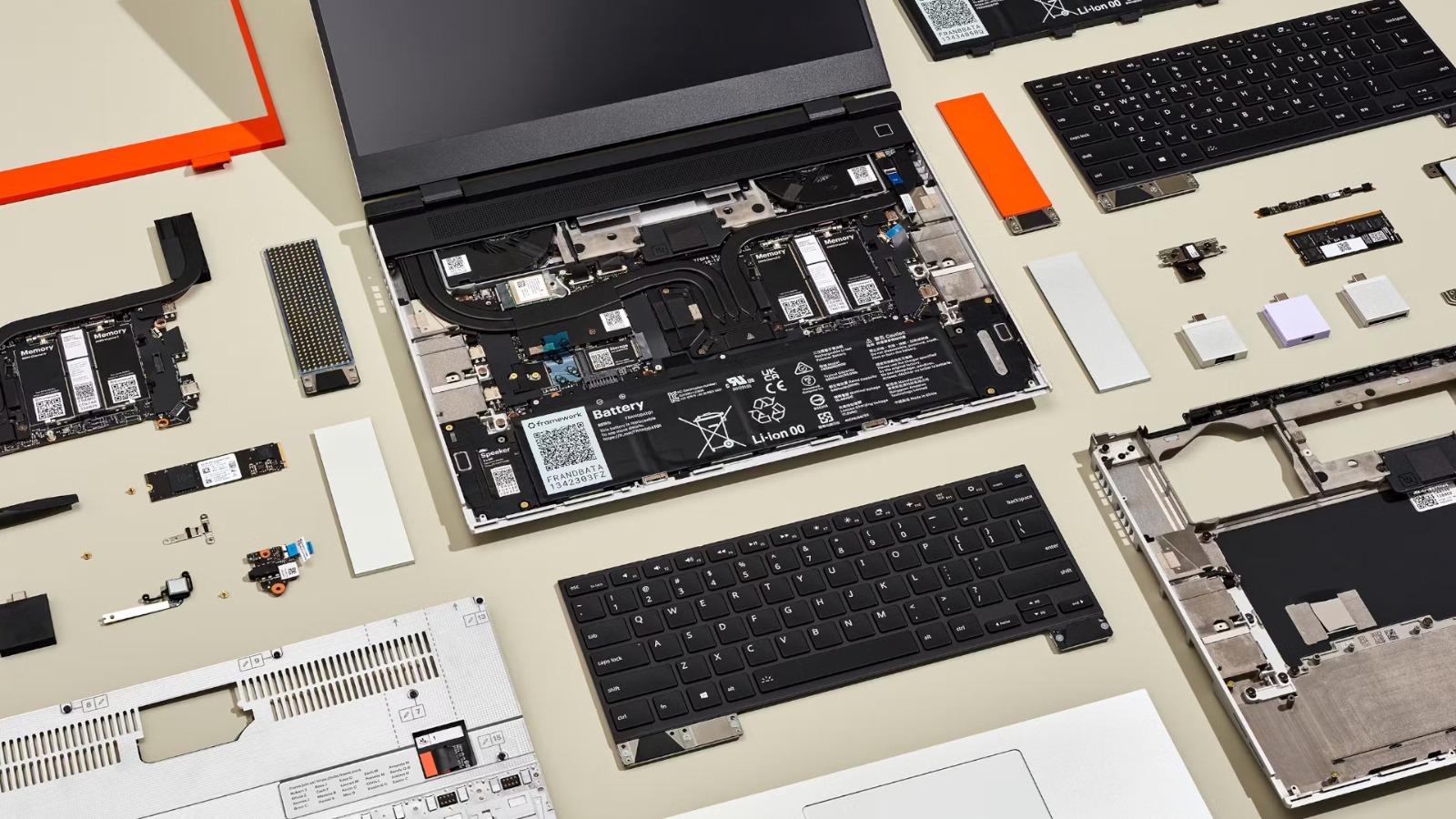
Modular Laptops: Build, Upgrade, and Repair with Ease.
Modular laptops are transforming personal computing by offering unprecedented flexibility, repairability, and sustainability. With swappable components, users can upgrade hardware, replace damaged parts, and customize their devices with ease. This approach reduces e-waste, extends device lifespans, and empowers consumers, making laptops not just tools but adaptable, long-lasting systems that evolve with technological advancements and user needs.
✨ Raghav Jain

Introduction: The Era of Modular Computing
In an industry long dominated by sealed devices and soldered components, the modular laptop emerges as a breath of fresh air. Traditional laptops have often forced consumers to choose between affordability and longevity—where upgrading RAM or replacing a damaged battery often meant buying an entirely new device. Modular laptops challenge that notion by allowing users to build, upgrade, and repair their devices as easily as snapping together LEGO bricks.
The concept of modularity in computing isn’t entirely new—it echoes the design of desktop PCs, where users can swap parts like processors, graphics cards, or storage drives. However, bringing this same philosophy to portable computing has been far more challenging. In recent years, thanks to innovations by companies like Framework, Dell, HP, and Lenovo, the dream of modular laptops is becoming a practical reality.
These devices are designed with interchangeable parts—from motherboards to USB ports, from keyboards to displays—allowing users to modify configurations, enhance performance, or replace damaged parts without discarding the entire machine. This flexibility promotes not only economic value but also environmental responsibility, extending the lifespan of laptops and significantly reducing electronic waste.
The Philosophy Behind Modularity
At its core, modularity is about freedom and sustainability. For decades, laptop manufacturers prioritized thinness and aesthetics over upgradability. Components were glued, soldered, and sealed—making repairs difficult and upgrades nearly impossible. This resulted in a “throwaway” culture where laptops became obsolete within three to five years.
Modular laptops disrupt this cycle. They are built on the principle of right to repair, giving users control over their devices. If your battery fails, you can replace it yourself. If your storage feels insufficient, you can add more. If technology advances, you can upgrade the motherboard without buying a new laptop shell.
This design philosophy aligns perfectly with sustainability goals and consumer empowerment—two themes increasingly shaping the future of technology.
How Modular Laptops Work
A modular laptop is composed of easily swappable components that can be independently replaced or upgraded. Let’s break down how they are typically structured:
- Core Chassis:
- The main body of the laptop—housing the keyboard, trackpad, and frame. It acts as the foundation to which other modules attach.
- Motherboard Module:
- Contains the CPU, GPU, and essential circuitry. Some designs allow swapping the entire motherboard, effectively upgrading to a new generation of processors without discarding the rest of the laptop.
- Storage and Memory Modules:
- Users can access slots to add or replace RAM and SSDs. This is a significant improvement over soldered configurations found in most modern ultrabooks.
- Battery and Power Modules:
- Modular laptops feature replaceable batteries—making it possible to extend lifespan or carry spares for longer use.
- Ports and Expansion Cards:
- Framework, for example, uses customizable expansion cards. Users can choose their preferred mix of USB-C, HDMI, microSD, or Ethernet ports and change them as needed.
- Display and Keyboard Modules:
- Damaged screens or malfunctioning keyboards can be replaced individually—no need to send the laptop for expensive servicing.
This modular structure means even users with minimal technical knowledge can handle basic repairs and upgrades using only simple tools.
The Benefits of Modular Laptops
1. Upgradability and Customization
Unlike traditional laptops, modular ones let users easily upgrade their system as technology evolves. Want a faster CPU or more storage? Just replace the relevant module instead of buying a new device. This makes modular laptops future-proof and cost-efficient.
2. Repairability and Longevity
Modular laptops promote the “repair, don’t replace” mindset. Each component can be replaced without professional service, reducing downtime and cost. This leads to longer product life cycles—sometimes doubling or tripling the usability of a single device.
3. Environmental Sustainability
E-waste is a global crisis—millions of tons of discarded electronics end up in landfills every year. Modular laptops combat this by ensuring fewer parts are thrown away. Replacing only specific modules drastically reduces the environmental footprint.
4. User Empowerment
These laptops put control back in the hands of the user. With open documentation and available spare parts, consumers are no longer dependent on authorized repair centers. This transparency strengthens the Right to Repair movement worldwide.
5. Cost-Effectiveness
Though the initial cost may be slightly higher, modular laptops are cheaper in the long run. Instead of spending $1,500 every few years, users can upgrade individual parts for a fraction of that cost.
Leading Modular Laptop Brands and Models
1. Framework Laptop
The Framework Laptop has become the face of the modular movement. Its design philosophy emphasizes openness and sustainability. Each component—from display bezels to the mainboard—is replaceable. The company even sells parts individually through its online marketplace, allowing users to customize or repair their systems with ease.
2. Dell Concept Luna
Dell’s Concept Luna represents a futuristic vision of sustainable design. The company is experimenting with completely tool-less assembly, biodegradable materials, and easy disassembly within minutes. It’s not fully commercial yet, but it demonstrates the industry’s commitment to circular design principles.
3. HP EliteBook and Lenovo ThinkPad Lines
While not fully modular like Framework, HP and Lenovo have introduced semi-modular features—such as replaceable batteries, memory, and storage. These incremental steps bridge the gap between traditional and fully modular designs.
4. Other Emerging Players
Smaller startups and DIY communities are also creating open-source modular laptops, such as MNT Reform—a Linux-based system focused on transparency, repairability, and ethical manufacturing.
Challenges and Limitations
Despite their advantages, modular laptops face several practical and commercial challenges:
- Higher Initial Cost:
- Because of smaller production volumes and specialized components, modular laptops are often more expensive upfront than mass-produced counterparts.
- Limited Market Adoption:
- Many consumers still prioritize slimness, aesthetics, and brand prestige over repairability. Until modular design becomes mainstream, economies of scale will remain a challenge.
- Performance Constraints:
- Modular laptops, especially early models, may lag slightly behind traditional ultrabooks in terms of compactness or thermal management due to their design flexibility.
- Design Trade-Offs:
- Creating universal parts that fit multiple generations of devices requires compromises in thickness, weight, and layout design.
- Manufacturer Resistance:
- Some major brands are reluctant to adopt modularity because it conflicts with the profitable business model of selling new laptops frequently.
Still, as awareness grows and sustainability becomes a global priority, these obstacles are gradually diminishing.
The Role of the Right to Repair Movement
The Right to Repair movement plays a crucial role in the adoption of modular technology. Advocates argue that consumers should have the legal right to repair and modify their devices without voiding warranties or relying solely on manufacturer services.
Governments in regions like the European Union and the United States have begun enforcing regulations that push companies to provide repair manuals, spare parts, and software tools. Modular laptops align perfectly with this legislation, as they are designed for accessibility and user serviceability from the start.
Environmental Impact: A Greener Future
One of the most compelling aspects of modular laptops is their contribution to sustainability. Electronic waste is one of the fastest-growing waste streams globally—over 50 million tons per year. Modular design combats this by extending device lifespans and minimizing waste.
Moreover, companies like Framework use recycled materials and eco-friendly packaging, setting new standards for green technology manufacturing. When parts can be reused or repurposed, fewer natural resources are consumed, and carbon emissions are drastically reduced.
The Future of Modular Laptops
The next decade could see modular laptops evolving from niche to norm. As consumer awareness grows, more companies are expected to adopt interchangeable architecture. We may also witness the rise of universal modules, compatible across different brands—similar to how USB standards became industry-wide.
Artificial intelligence (AI) and smart diagnostics may integrate with modular designs to predict component failures, recommend upgrades, or even automate firmware updates.
Imagine a laptop that tells you, “Your storage module is wearing out—would you like to order a new one?” That’s where modular computing is headed.
In a world increasingly driven by sleek, minimalist, and non-repairable technology, modular laptops have emerged as a refreshing alternative—one that challenges the status quo and redefines how we view personal computers. A modular laptop is built on the simple yet transformative idea that every major component—from the CPU to the battery—should be replaceable, upgradable, and repairable by the user without requiring professional help. This design philosophy promotes not only personal freedom and economic value but also environmental sustainability. For decades, mainstream laptop manufacturers have prioritized compactness and design over flexibility. Components have been glued, soldered, or sealed within tight aluminum chassis, making it nearly impossible to repair or upgrade them. As a result, millions of perfectly functional laptops are discarded each year simply because one component failed or became outdated. Modular laptops directly counter this throwaway culture by giving users control over their devices, extending their lifespan, and ensuring that technology remains adaptable to changing needs. These laptops typically feature swappable modules for storage, memory, ports, batteries, and even motherboards—allowing owners to configure their systems according to preference and performance requirements. For instance, if a user wants more storage space, they can simply replace the SSD module. If the processor becomes outdated, a new motherboard module can be installed instead of purchasing an entirely new machine. Companies like Framework, Dell, HP, and Lenovo have taken major strides in this direction, with the Framework Laptop becoming a pioneer of the modular computing revolution. Its modular design allows users to replace almost every component—from the keyboard and bezels to the motherboard and display—without any specialized tools. Dell’s Concept Luna, on the other hand, envisions a future of completely tool-less assembly, biodegradable materials, and disassembly within minutes, representing a bold step toward sustainability. HP and Lenovo have also integrated semi-modular elements into their laptops, such as replaceable memory, batteries, and SSDs, marking a transitional phase toward fully modular ecosystems. The benefits of modular laptops extend far beyond mere convenience; they embody a new technological ethic rooted in sustainability, repairability, and user empowerment. By enabling individual component replacement, these laptops drastically reduce electronic waste, which has become one of the fastest-growing environmental concerns globally. According to industry reports, over 50 million tons of e-waste are generated annually, much of which ends up in landfills, releasing toxic materials into the environment. Modular design helps mitigate this crisis by ensuring that fewer devices are thrown away—users can keep their laptops for 7 to 10 years or more, upgrading only the necessary parts. Economically, modular laptops are a smart investment. Although their upfront cost may be higher, they prove far more cost-effective over time since users can avoid buying a new device every few years. Instead, they can upgrade individual components for a fraction of the cost. This modularity also encourages experimentation and learning—people with minimal technical skills can now open up their laptops, replace parts, and understand how their machines work, thereby fostering digital literacy and self-reliance. Another critical factor driving the popularity of modular laptops is the Right to Repair movement, which advocates that consumers should have the legal right to repair their devices and access parts, tools, and documentation without voiding warranties. Governments in regions like the European Union and the United States have begun passing legislation supporting this cause, forcing manufacturers to provide accessible repair options. Modular laptops fit perfectly within this framework, offering users unprecedented transparency and control. They also symbolize a growing resistance to planned obsolescence—a business strategy where companies intentionally limit product longevity to drive sales of new models. Beyond their environmental and economic benefits, modular laptops also appeal to tech enthusiasts and professionals who want custom configurations. Much like building a desktop PC, modular laptops allow users to choose exactly what they need—whether it’s a high-performance processor for gaming, more RAM for multitasking, or specific ports for creative work. Framework’s customizable expansion cards, for example, let users swap out USB-C, HDMI, or microSD ports depending on their workflow. This flexibility means a single device can serve diverse purposes, evolving alongside its owner’s needs. However, despite their advantages, modular laptops are not without challenges. Their initial prices are often higher due to limited production volumes and the specialized engineering required to make each part independently replaceable. Some models may also sacrifice a bit of compactness or thermal efficiency compared to their sealed counterparts. Additionally, market adoption remains slow as most consumers still favor familiar, brand-heavy devices over emerging sustainable alternatives. Manufacturers, too, are hesitant to embrace modularity fully, as it threatens the highly profitable cycle of frequent hardware upgrades. Yet, as global awareness of sustainability grows, and as repair laws tighten, these obstacles are steadily being overcome. In terms of technological evolution, modular laptops are expected to become even more advanced in the near future. The next generation may include universal module compatibility across brands, standardized connectors, and even AI-assisted diagnostics capable of predicting when a component is likely to fail. Imagine owning a laptop that notifies you when your battery health is declining and offers a direct link to order a replacement module—this is the intelligent, sustainable computing ecosystem modularity promises to build. Moreover, modular technology is not confined to laptops alone; it could soon expand to smartphones, tablets, and other electronics, creating a truly circular economy where devices are designed to evolve, not expire. Companies like Framework already sell individual parts directly to customers, and users can even upgrade their existing laptop’s core with new generations of mainboards while keeping the same chassis and display. This level of flexibility is unmatched in the traditional laptop market. From an environmental perspective, modular laptops also utilize recycled materials and eco-friendly packaging, aligning with global efforts to achieve net-zero emissions. They represent a tangible, consumer-driven response to climate change and resource depletion. The idea that technology can be sustainable, repairable, and long-lasting is gaining traction, and modular laptops are at the forefront of this transformation. While they may currently serve a niche audience of environmentally conscious users and tech enthusiasts, the growing emphasis on repairability and longevity ensures that modular laptops will soon become mainstream. Ultimately, modular laptops symbolize much more than a hardware innovation—they represent a philosophical shift toward conscious consumption, technological transparency, and ecological responsibility. They prove that progress doesn’t have to come at the cost of the planet. As more people embrace the idea of technology that adapts and endures, modular laptops could redefine the future of personal computing, where every user has the power to build, upgrade, and repair their own digital world with ease.
In the rapidly evolving world of personal computing, modular laptops have emerged as a revolutionary concept, redefining the way people interact with technology and challenging the traditional norms of device ownership, repair, and upgrade cycles, because for decades, laptops have been designed with sealed and soldered components that make upgrades and repairs either extremely difficult or virtually impossible, forcing consumers into a cycle of replacing their machines every few years and contributing significantly to the global e-waste problem, which has now reached alarming levels with over 50 million tons of electronic waste generated annually, much of which contains toxic metals and plastics that are harmful to the environment; in contrast, modular laptops embrace the philosophy of repairability, upgradability, and user empowerment, giving individuals the ability to replace, upgrade, or customize almost every component of their device, including the processor, RAM, storage, battery, ports, and even the display or keyboard in some models, thus dramatically extending the lifespan of the machine and providing significant long-term economic benefits, as users no longer need to invest in entirely new devices simply because a single component has failed or become outdated, which also promotes sustainability by reducing the number of laptops that are prematurely discarded; companies like Framework have been pioneers in this domain, designing laptops with fully modular architectures where users can order replacement modules directly from the manufacturer or third-party vendors and install them with minimal tools, effectively democratizing hardware repair and customization in a manner previously restricted to desktop PCs, while other major players such as Dell with its Concept Luna, HP, and Lenovo have started incorporating semi-modular features such as swappable batteries, storage drives, and memory modules, signaling a broader industry trend toward more repairable and sustainable computing solutions; the modular design is not only beneficial for individual users but also has broader implications for the environment, as it directly addresses the growing concerns regarding electronic waste, energy consumption, and resource depletion, because extending the lifespan of devices and allowing for incremental upgrades reduces the demand for new manufacturing, conserves raw materials such as rare earth metals, and minimizes the carbon footprint associated with producing and shipping entirely new laptops; furthermore, modular laptops align perfectly with the global Right to Repair movement, which advocates for consumer rights to access repair manuals, spare parts, and the tools necessary to service their devices without voiding warranties, and as governments in regions like the European Union and the United States pass legislation supporting repairability, these laptops are uniquely positioned to meet both consumer and regulatory demands by offering open documentation, accessible parts, and user-friendly assembly processes, thus empowering users to take control of their technology while fostering a culture of sustainability and responsible consumption; the practical benefits of modular laptops are extensive: users can upgrade their CPU or GPU to stay current with the latest software demands without replacing the entire system, expand RAM and storage to meet growing needs, replace aging batteries to maintain performance, and swap out damaged keyboards or screens without incurring the high costs typically associated with professional repairs, making these devices particularly attractive to tech enthusiasts, students, creative professionals, and environmentally conscious consumers alike, who value both performance and longevity; moreover, modular laptops facilitate innovation by encouraging experimentation and personalization, as users can mix and match components, select expansion cards such as USB-C, HDMI, or Ethernet, and optimize configurations for specific use cases, from gaming and video editing to professional productivity and coding, effectively creating a level of customization previously unavailable in portable computing; however, the journey toward widespread adoption of modular laptops is not without challenges, including higher upfront costs due to specialized engineering, limited economies of scale, minor compromises in design aesthetics or compactness, and the inertia of consumer habits that favor brand loyalty, thin form factors, and glossy marketing over repairability, yet these barriers are gradually diminishing as awareness grows regarding the environmental impact of disposable electronics, the cost savings of incremental upgrades, and the empowerment that comes from controlling one’s own device, making modular laptops increasingly appealing as a practical and ethical choice; additionally, emerging trends suggest that the future of modular laptops could include standardized modules across multiple brands, AI-driven predictive diagnostics that alert users to impending component failures, and enhanced integration with cloud services and smart software ecosystems, all of which would make the maintenance, upgrading, and personalization of laptops even more seamless, efficient, and accessible to everyday users; from a technological perspective, modular laptops are also inspiring innovations in sustainable manufacturing, with companies experimenting with recycled materials, eco-friendly packaging, and biodegradable components, demonstrating that cutting-edge computing does not have to come at the expense of the environment, while simultaneously challenging the industry’s long-standing reliance on planned obsolescence and disposable hardware cycles; in essence, modular laptops represent a profound paradigm shift in personal computing, merging practical functionality, economic efficiency, environmental responsibility, and consumer empowerment in a single, elegant design, and as the market matures and awareness spreads, they are likely to become not just a niche product for enthusiasts but a mainstream option that redefines the very concept of device ownership, proving that technology can be both powerful and sustainable, adaptable to the user’s evolving needs while minimizing its ecological footprint, ultimately setting a new standard for how personal devices are designed, used, and maintained in the modern era of conscious consumption, longevity, and responsible technological advancement, and serving as a blueprint for future electronics where repair, customization, and modularity are the default rather than the exception.
Conclusion
Modular laptops are redefining what it means to own a computer. They merge flexibility, sustainability, and affordability in a single, user-friendly package. While still in their early stages, modular laptops represent a paradigm shift toward conscious consumption and responsible technology.
By allowing users to build, upgrade, and repair with ease, these laptops empower consumers and protect the planet. They embody the future—where devices aren’t disposable but adaptable, evolving alongside human needs and technological progress.
In the coming years, modular design principles will likely expand beyond laptops—to smartphones, tablets, and even home appliances—ushering in an age of interchangeable technology ecosystems. The modular laptop is just the beginning of that revolution.
Q&A Section
Q1: What is a modular laptop?
Ans: A modular laptop is a computer designed with interchangeable parts that can be easily upgraded or replaced, such as the motherboard, battery, storage, or ports, allowing users to customize and repair the device without professional help.
Q2: How do modular laptops differ from traditional laptops?
Ans: Traditional laptops often have sealed or soldered components, making repairs difficult. Modular laptops, on the other hand, use detachable and replaceable modules—promoting flexibility, longevity, and easy maintenance.
Q3: What are the key benefits of modular laptops?
Ans: They offer easy upgrades, cost savings over time, reduced e-waste, user empowerment through repairability, and better environmental sustainability compared to disposable laptops.
Q4: Are modular laptops more expensive?
Ans: Initially, yes, due to lower production volumes. However, they become cost-effective in the long term because users only need to replace individual parts instead of the entire laptop.
Q5: Which companies make modular laptops?
Ans: Leading brands include Framework, Dell (Concept Luna), HP, Lenovo, and open-source initiatives like MNT Reform, all promoting various levels of modularity.
Similar Articles
Find more relatable content in similar Articles

AI in detecting and preventing..
Artificial Intelligence (AI) i.. Read More

Ethical AI: Can Machines Ever ..
Exploring the challenges and p.. Read More

Modular Laptops: Build, Upgrad..
Modular laptops are transformi.. Read More

Space tech for Earth problems:..
Leveraging the power of satell.. Read More
Explore Other Categories
Explore many different categories of articles ranging from Gadgets to Security
Smart Devices, Gear & Innovations
Discover in-depth reviews, hands-on experiences, and expert insights on the newest gadgets—from smartphones to smartwatches, headphones, wearables, and everything in between. Stay ahead with the latest in tech gear
Apps That Power Your World
Explore essential mobile and desktop applications across all platforms. From productivity boosters to creative tools, we cover updates, recommendations, and how-tos to make your digital life easier and more efficient.
Tomorrow's Technology, Today's Insights
Dive into the world of emerging technologies, AI breakthroughs, space tech, robotics, and innovations shaping the future. Stay informed on what's next in the evolution of science and technology.
Protecting You in a Digital Age
Learn how to secure your data, protect your privacy, and understand the latest in online threats. We break down complex cybersecurity topics into practical advice for everyday users and professionals alike.
© 2025 Copyrights by rTechnology. All Rights Reserved.